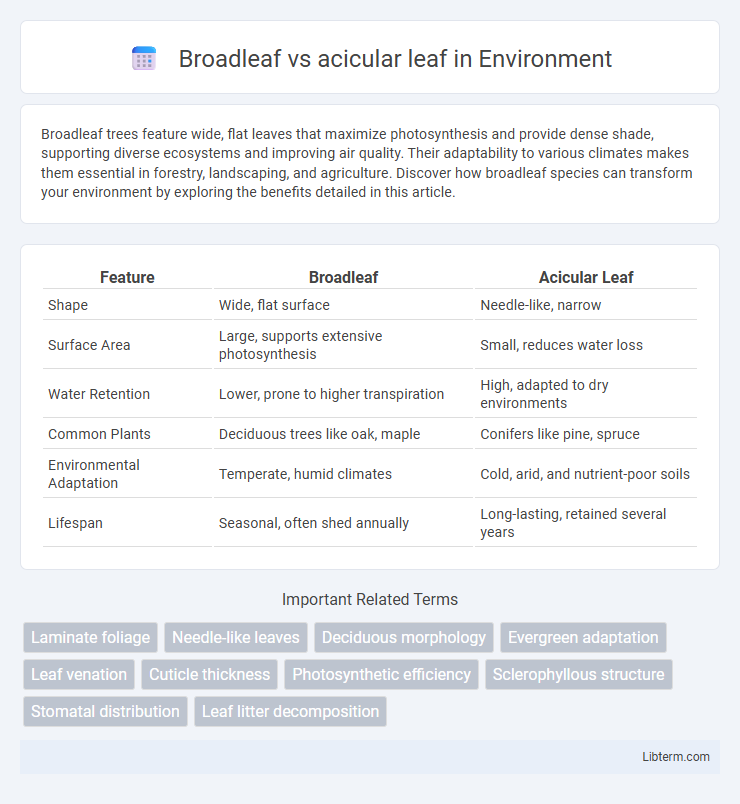Broadleaf trees feature wide, flat leaves that maximize photosynthesis and provide dense shade, supporting diverse ecosystems and improving air quality. Their adaptability to various climates makes them essential in forestry, landscaping, and agriculture. Discover how broadleaf species can transform your environment by exploring the benefits detailed in this article.
Table of Comparison
| Feature | Broadleaf | Acicular Leaf |
|---|---|---|
| Shape | Wide, flat surface | Needle-like, narrow |
| Surface Area | Large, supports extensive photosynthesis | Small, reduces water loss |
| Water Retention | Lower, prone to higher transpiration | High, adapted to dry environments |
| Common Plants | Deciduous trees like oak, maple | Conifers like pine, spruce |
| Environmental Adaptation | Temperate, humid climates | Cold, arid, and nutrient-poor soils |
| Lifespan | Seasonal, often shed annually | Long-lasting, retained several years |
Introduction to Broadleaf and Acicular Leaf Types
Broadleaf leaves are typically wide, flat, and have a broad surface area that maximizes photosynthesis, commonly found in deciduous trees like oaks and maples. Acicular leaves are needle-shaped, slender, and adapted to conserve water, characteristic of coniferous trees such as pines and firs. These contrasting leaf types reflect evolutionary adaptations to different environmental conditions and play crucial roles in plant identification and ecology.
Morphological Differences Between Broadleaf and Acicular Leaves
Broadleaf leaves exhibit a wide, flat shape with a broad surface area that enhances photosynthesis through increased light absorption, while acicular leaves are slender, needle-like, and typically adapted to reduce water loss in harsh environments. The broadleaf morphology includes a complex network of veins spread widely across the leaf blade, contrasting with the simple, linear venation found in acicular leaves. These distinct morphologies reflect evolutionary adaptations to different ecological niches, with broadleaves favoring moisture-rich habitats and acicular leaves thriving in arid or cold settings.
Photosynthetic Efficiency in Broadleaf vs Acicular Leaves
Broadleaf leaves typically exhibit higher photosynthetic efficiency due to their larger surface area, enhancing light capture and gas exchange compared to acicular leaves. Acicular leaves, common in conifers, have a reduced surface area which limits water loss but also decreases the overall photosynthetic capacity. The thicker cuticle and sunken stomata in acicular leaves optimize water retention but reduce CO2 uptake, impacting photosynthesis relative to broadleaf species.
Adaptations to Environment: Broadleaf vs Acicular Leaf Plants
Broadleaf plants exhibit large, flat leaves designed to maximize photosynthesis in environments with abundant sunlight and water, often featuring stomata distribution that balances gas exchange and water retention efficiently. Acicular leaf plants, such as conifers, have needle-like leaves with thick cuticles and sunken stomata to reduce water loss, making them highly adapted to cold, dry, or nutrient-poor habitats. These structural differences reflect evolutionary adaptations that optimize water conservation and photosynthetic efficiency according to environmental conditions.
Distribution and Habitat Preferences
Broadleaf plants predominantly thrive in temperate and tropical regions with diverse ecosystems such as forests and woodlands, where moisture availability supports their larger leaf surface area for photosynthesis. Acicular leaves, characteristic of many conifers, are commonly found in cold, dry, or nutrient-poor environments like boreal forests and mountainous habitats, due to their needle-like shape which reduces water loss and withstands harsh conditions. Distribution patterns highlight that broadleaf species dominate wetlands and rainforests, while acicular-leaved plants are adapted to survive in climates with seasonal extremes and limited water resources.
Water Retention and Transpiration Comparisons
Broadleaf plants have larger surface areas that increase transpiration rates, leading to higher water loss, while acicular leaves possess narrow, needle-like shapes that reduce surface area and minimize water loss through transpiration. The thick cuticles and sunken stomata on acicular leaves enhance water retention by reducing evaporation, making them more suited for arid environments compared to broadleaf species. Broadleaf plants typically require more water and are less efficient in water retention, especially in dry conditions, due to their expansive leaf morphology.
Common Plant Species with Broadleaf and Acicular Leaves
Common plant species with broadleaf include maple (Acer spp.), oak (Quercus spp.), and magnolia (Magnolia spp.), characterized by wide, flat leaves optimizing photosynthesis in diverse environments. Acicular leaves are typical of conifers such as pine (Pinus spp.), spruce (Picea spp.), and fir (Abies spp.), adapted for water retention and survival in cold or dry climates. The distinct morphology of broadleaf and acicular species influences their ecological roles and habitat preferences worldwide.
Seasonal Variations and Leaf Longevity
Broadleaf plants typically exhibit pronounced seasonal variations, with leaves undergoing color changes in autumn before shedding, reflecting their deciduous nature and shorter leaf longevity lasting several months to a year. In contrast, acicular leaves, common in conifers like pines and firs, demonstrate minimal seasonal change, often retained for multiple years, which enhances year-round photosynthesis and conserves water in colder or drier environments. These differences in leaf structure and lifespan contribute to distinct ecological strategies for survival and energy use across temperate and boreal biomes.
Ecological Roles of Broadleaf and Acicular Leaves
Broadleaf leaves, with their wide surface area, enhance photosynthesis by capturing more sunlight, supporting higher primary productivity in diverse ecosystems such as deciduous forests. Acicular leaves, commonly found in conifers, reduce water loss and withstand colder, drier climates, playing a vital role in boreal forest resilience and carbon sequestration. The ecological adaptation of broadleaf and acicular leaves influences species distribution, ecosystem stability, and habitat complexity across different biomes.
Summary: Choosing Between Broadleaf and Acicular Leaf Plants
Broadleaf plants feature wide, flat leaves that maximize photosynthesis and are common in deciduous forests, while acicular leaf plants, characterized by needle-like leaves, are well-adapted to conserve water in coniferous environments. Choosing between broadleaf and acicular leaf plants depends on climate, water availability, and aesthetic preferences, as broadleaf plants thrive in moist, temperate regions and acicular leaves excel in dry or cold habitats. Understanding these leaf adaptations helps optimize plant selection for landscaping, forestry, and ecological restoration projects.
Broadleaf Infographic

 libterm.com
libterm.com